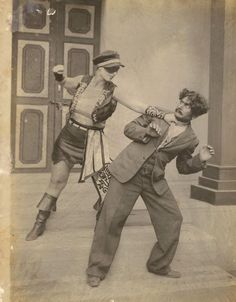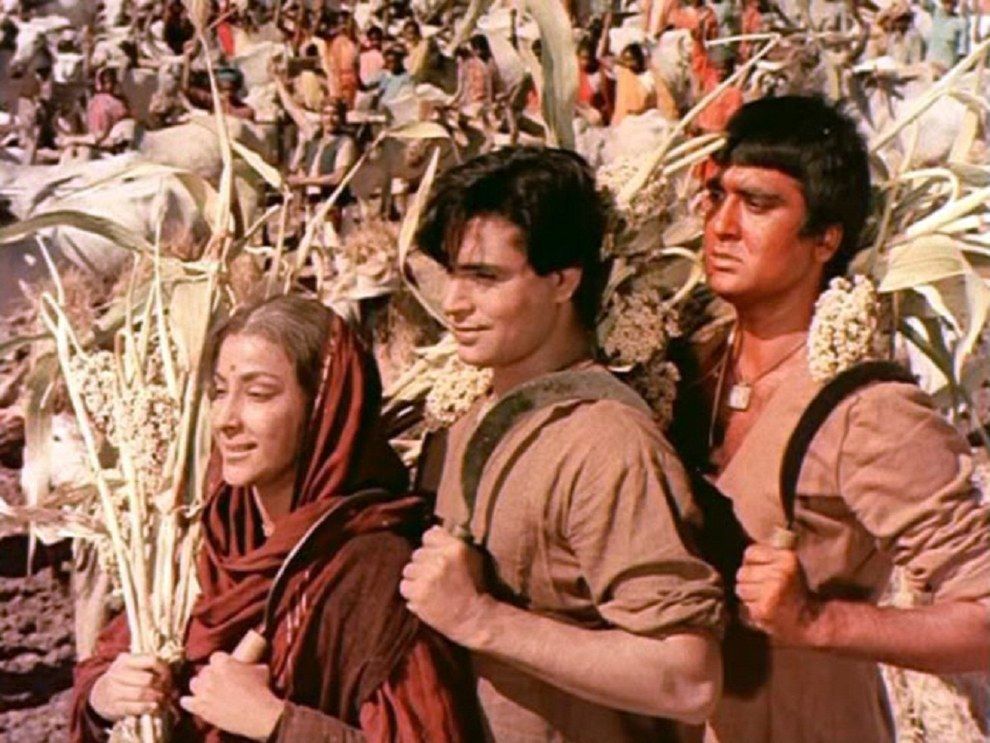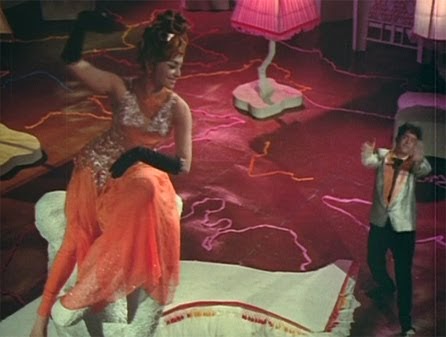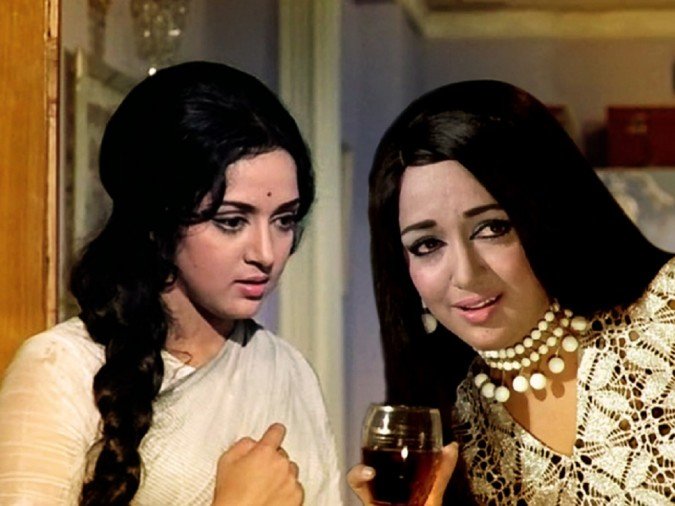The masked vigilante, Hunterwali, swings her whip and yells “Hey-y-y-y” as she wards off villains from atop a moving train with complex acrobatic stunts, bringing justice to her people.

This is not a familiar sight on celluloid. It has long been known and said that in mainstream Bollywood films, women have mostly played roles that are marginal or less important. Sometimes as showpieces to please the eye, other times narrowly confined to patriarchal expectations – as the silent sufferer and spectator in the world of men, as the object to desire and attain, as the cautionary tale, or the mother, the sister, the wife, the lover. Feminist film theorist Laura Mulvey has famously critiqued popular cinema for how its women are characterised by their “to be looked- at-ness”, as objects of the heterosexual masculine gaze. While men drive the story forward as active agents, women seem to stop narrative time as they grace the screen to be gazed at and enjoyed. So then how does Bollywood create and view an “empowered woman”? How do “women-centric” or more socially conscious films look at a term that is so often the catchphrase in government policy, advertisement, and the language of corporate social responsibility: “women’s empowerment”?
Films in the colonial era often told already-heard stories, depending more on the novelty of film technology to attract audiences. Stories from the Ramayana and Mahabharata and biopics of saints and poets were used to hark back to a pre-colonial past. Despite strict colonial censorship laws, nationalist and anti- colonial symbols were used to mobilise mass support. In the words of historian Partha Chatterjee, the nationalist movement created a distinction between two distinct spheres : the spiritual and the material. The material realm is one of the outside, belonging to men: economy and statecraft, with the West leading the way. But it was the spiritual sphere in which Indian culture was distinct, autonomous and superior to the British, and this was the strength of the national movement. It was this inner spiritual realm that created the ‘new Indian woman’ who was the guardian of this spiritual world, symbolised by the home. Most women, especially from middle and upper class Hindu and Muslim families, did not enter films, as it was often equated with sex work and not considered ‘respectable’. The women who acted in the 1920s and 30s were thus often Anglo- Indian women such as Dorothy Kingdom or Ruby Myers, comparatively less constrained by the expectation to remain within the home. In fact, Dorothy Kingdom starred in the first film to address the “woman question”, in the film Gunsundari (Why Husbands Go Astray, 1927).

In the 1930’s, a young set designer called Devika Rani eventually went on to star in many films and become the “first lady of the Indian screen”. Especially famous for her role in “Achhut Kanya” (1936) that looked at inter-caste romance , Devika Rani very much represented the modern Indian woman, but a woman limited by patriarchal expectations, who dies to save her husband and whose death ultimately maintains the existing order. Around the same time as Devika Rani was pioneering the role of the ‘village belle’, another woman was quickly capturing the box office with her famous lines “Aaj se main Hunterwaali hoon!”: Tall, strapping, whip – cracking Nadia, lovingly called Fearless Nadia. She too played an important role in the nationalist movement. But rather than being the pure gatekeeper of the spiritual realm, she was the brave Indian girl who sacrificed comfort for her nation. This was around the time that various ‘virangana stories’ had begun to emerge within the nationalist movement, exemplified by figures such as Jhansi ki Rani. The virangana was ‘respected’ for her own noble deeds rather than her relationship with a man, giving her a sense of freedom and agency almost akin to men. Virangana Nadia, in films like Hunterwaali (1935) and Diamond Queen (1940) was trained in combat, sat on horseback, righted all wrongs and had relative sexual freedom. Devika Rani and Nadia represent two forms of the empowered woman in the 1940s. As Rosie Thomas writes, ‘while Devika Rani’s attempts to challenge traditional orthodoxies in Achhut Kanya left her crushed under the wheels of an oncoming train, Nadia.. effected change in the world from the giddy heights of the train roof’.
In the post Independence era, there were dramatic shifts in the industry. Nehruvian ideas of secularism and social progress, the growth of the Indian People’s Theatre Association and the Progressive Writers’ Association led to a new genre: ‘the social film’, helmed by directors like Bimal Roy, Mehboob Khan and Guru Dutt. While the idea of social and gender reform was common in these films, women primarily played the role of the lover, the wife, the mother. The mother as a strong and virtuous character was exemplified by Nargis’s role in Mother India (1957).

The empowered woman in the 1950s thus morphed into that of the righteous self – sacrificing mother, glorifying the strength of a woman. Made ten years after Independence, the director, Mehboob Khan, drew from various nationalist and mythological symbols to symbolically equate the woman and the Nation. The nationalist movement often personified the nation as a woman in a saree, a Mother Goddess or “Bharat Mata”. The film’s narrative revolves around Radha (Nargis) as the main character who drudges through poverty and misfortune to transform from a young submissive wife into an old powerful matriarch of the village. Throughout her life, she remains chaste and devoted to her family, but ultimately when she realises that her beloved son has abducted a young woman, she kills him, because her sense of justice is larger than even her motherly love. This mother is no longer just the background to a man’s story, but an active narrative agent – she is “Mother India”. However, she also exemplified the masculine fantasy of the deified ideal woman, who sets the high moral standards of womanhood, bearing the responsibility of being the Hindu symbol of pure feminine virtue. If we compare Mother India with Fearless Nadia, while both stood for justice and were in service of the nation, Nadia had much more agency and sexual freedom.
In the 1960s, social films are replaced by action and romance films. What is significant in the 1960s is the emergence of a binarized femininity: the good woman/bad woman or Sita/Gita. The good woman is the self sacrificing mother, the submissive lover, the caring wife. The bad woman or the “other woman” competes for the hero while smoking, drinking, being overly sexual and Westernized, and generally lacking the morals possessed by the leading lady. Much like male villains, a few women became typecast as “vamps”, the most famous among them being Helen, playing the “vamp” in over 700 films. Her character offered the antithesis against which idealized Indian femininity could be reiterated. She rarely had “Hindu sounding” names, often being called Dolly, Jenny, Salma, Ruksana or Laila. The vamp is a female character depicted as having freedom and a mind of her own. The “good woman” may get the man but the “bad woman” has autonomy and agency, and often, she is punished for this. For example, in “Teesri Manzil”, Helen plays the role of the vamp (Ruby), a nightclub dancer. She is sexually alluring and aggressively pursues the hero, and is ultimately murdered. There was also the ‘double role’ trope, like in Sita/Gita, or An Evening in Paris where Sharmila Tagore played both Deepa and Suzy, donning the saree as one and a bikini as the other.

Directors in the 1960s also began to look at various issues of women’s marginalisation – and many heroines were depicted as working professionals in cities, but this usually emerged within the ‘marginalized’ trope – of the assertive and independent character that defies patriarchal norms and then is stigmatized for her transgressions. Within this trope came the courtesan film. Unlike the vamp who is always the ‘bad’ woman, the courtesan, prostitute or court dancer is a complex figure. She is well versed in high culture, is highly educated and skilled. She has the agency to reject suitors, make her own money and control her own sexuality, but she is also an object of male desire. One of the first films to look at a prostitute is Guru Dutt’s “Pyaasa”, where Gulabo (Waheeda Rehman) is a self sufficient and hard working sex worker, unlike the hero Vijay’s wife, who is weak and dependent. In the end, Vijay asks Gulabo to accompany him as they together renounce the materialistic world. Another famous character is Anarkali in Mughal-E-Azam, who is unafraid to love Prince Salim despite the entire kingdom and Emperor Akbar being against it. In the end, she agrees to be entombed to a brick wall in order to save Salim, and the transgression of class boundaries fails. But her words in the famous song “Jab pyaar kiya toh darna kya” remain immortalized, with the song becoming a call to so many to love without fear of boundaries. Similarly, in Pakeezah (1970), Meena Kumari plays the role of a courtesan, and is often referred to as ‘pure’ by the hero, who ultimately leaves his family to be with her. The figure of the courtesan was thus a complex one, of the woman to be saved, or a woman who continued to live life despite great odds, but it offered a sympathetic look at an independent woman breaking norms.

By the 1970s, post Emergency, there was a sense of disillusionment with the State. The new hero was no longer the hero of the social reform film or a symbol of nationalism, but rather the anti- hero, the ‘angry young man’, epitomized by Amitabh Bachchan of Sholay. The Helen-esque vamp was also slowly replaced by heroines that no longer needed to be chaste figures. The boundary between the good woman and the vamp was blurred with the emergence of the independent, westernised woman of the 1970s. The 1930s to the 1960s thus marked an era where themes of nation building and social progress dominated, creating varying versions of the empowered woman: the upholder of moral standards, the bringer of justice, the marginalised transgressor, the vamp and the courtesan, each limited in her own ways by patriarchal shackles.




